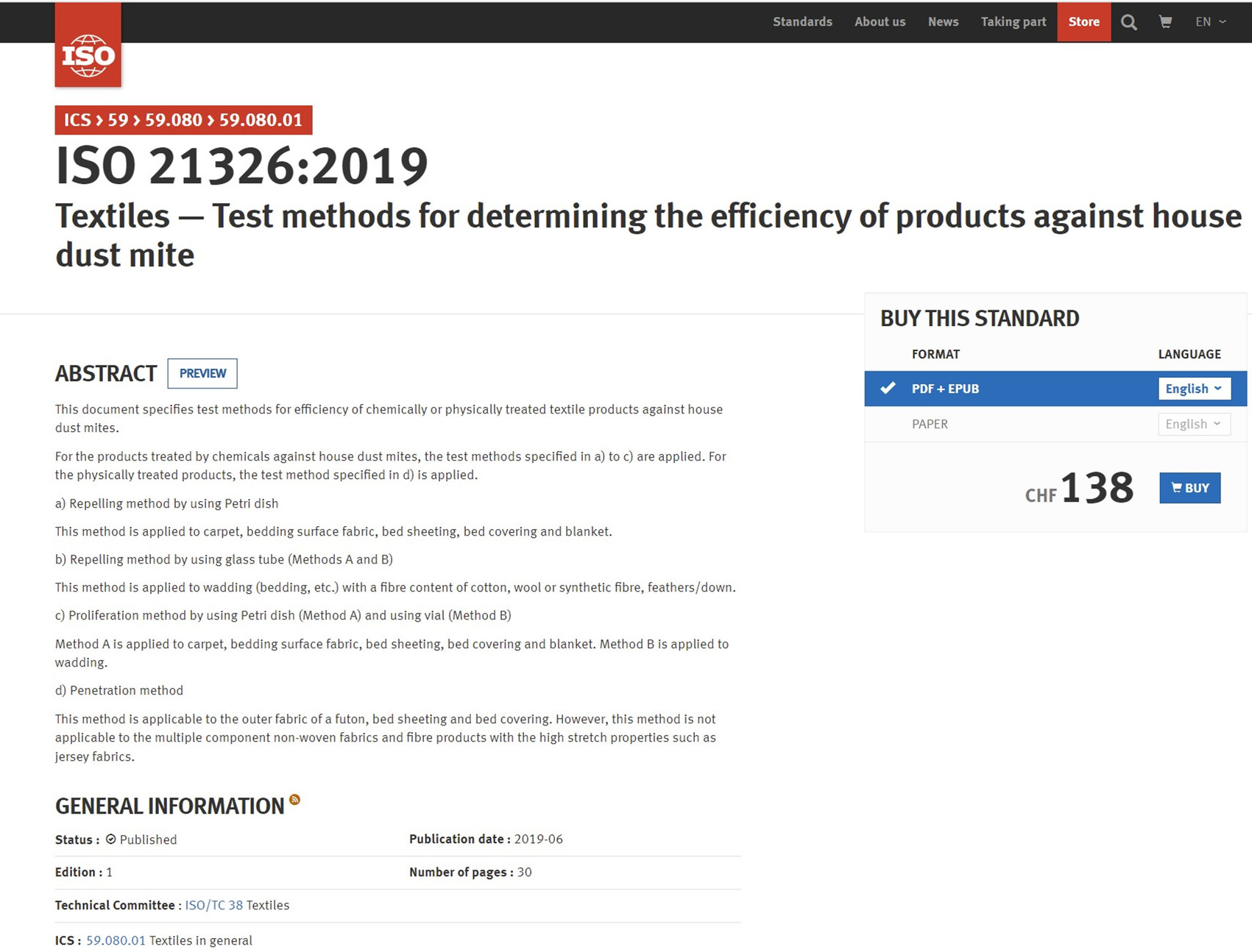纺织品 测定产品抗室内尘螨效率的试验方法
时间:2022-05-12 09:45:03 来源:ISO 点击量:

标准编号:ISO 21326:2019
英文名称:Textiles — Test methods for determining the efficiency of products against house dust mite
Introduction
The World Health Organization's (WHO) statement on the correlation of house dust mite to asthma and other allergic disorders resulted in the increased number of textile products treated against house dust mite available to the consumer.
However, the testing method to evaluate the efficacy against house dust mite of textiles has not been standardized to date. This has caused confusion among consumers because of various testing methods and results.
The purpose of this test method is to standardize the testing method of efficacy of products against house dust mite in textiles.
1 Scope
This document specifies test methods for efficiency of chemically or physically treated textile products against house dust mites.
For the products treated by chemicals against house dust mites, the test methods specified in a) to c) are applied. For the physically treated products, the test method specified in d) is applied.
a) Repelling method by using Petri dish
This method is applied to carpet, bedding surface fabric, bed sheeting, bed covering and blanket.
b) Repelling method by using glass tube (Methods A and B)
This method is applied to wadding (bedding, etc.) with a fibre content of cotton, wool or synthetic fibre, feathers/down.
c) Proliferation method by using Petri dish (Method A) and using vial (Method B)
Method A is applied to carpet, bedding surface fabric, bed sheeting, bed covering and blanket. Method B is applied to wadding.
d) Penetration method
This method is applicable to the outer fabric of a futon, bed sheeting and bed covering. However, this method is not applicable to the multiple component non-woven fabrics and fibre products with the high stretch properties such as jersey fabrics.
2 Normative references
The following documents are referred to in the text in such a way that some or all of their content constitutes requirements of this document. For dated references, only the edition cited applies. For undated references, the latest edition of the referenced document (including any amendments) applies.
ISO 105-F02, Textiles — Tests for colour fastness — Part F02: Specification for cotton and viscose adjacent fabrics
ISO 3310-1, Test sieves — Technical requirements and testing — Part 1: Test sieves of metal wire cloth
ISO 3696, Water for analytical laboratory use — Specification and test methods
ISO 9237, Textiles — Determination of the permeability of fabrics to air
3 Terms and definitions
For the purposes of this document, the following terms and definitions apply.
ISO and IEC maintain terminological databases for use in standardization at the following addresses:
— ISO Online browsing platform: available at https://www.iso.org/obp
— IEC Electropedia: available at http://www.electropedia.org/
3.1
house dust mite
universal dominant species belonging to Pyroglyphidae, observed in or on floor surfaces, carpets and bedding with house dust as example
3.2
efficiency of repellency
efficiency of the treatment in repelling house dust mites
3.3
rate of repellency
ratio of the number of live mites in treated material against the number of live mites in untreated material
Note 1 to entry: The rate of repellency is expressed in percentage (%) and represents the efficacy of repellency of treated materials.
3.4
rate of suppression of house dust mite reproduction
ratio of the number of live mites in treated material against the number of live mites in untreated material tested by the proliferation method
Note 1 to entry: The rate of suppression for reproduction of house dust mite is expressed in percentage (%) and represents the degree of population control of treated materials.
3.5
culture medium
diet for breeding house dust mite
3.6
mite medium
mix of diet and live house dust mite
3.7
live mite
mites which react when stimulated from the outside
Note 1 to entry: It includes all of larva, nymph (protonymph and tritonymph) and adult mites but exclude eggs.
3.8
population density
degree of live mites in a mite medium
Note 1 to entry: The number of live mites in 1 g of the mite medium.
3.9
quiescent period
period in the stage in which activity of mites almost stops and is observed in the latter half of each development period of a larva, protonymph and tritonymph
CIAA会员单位免费下载
